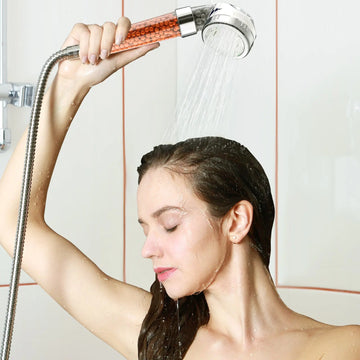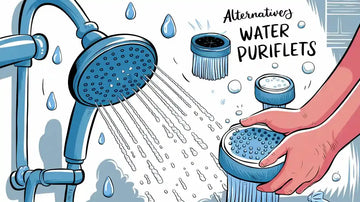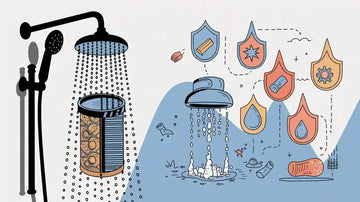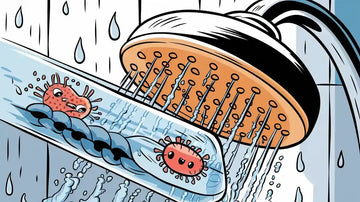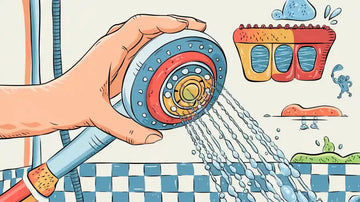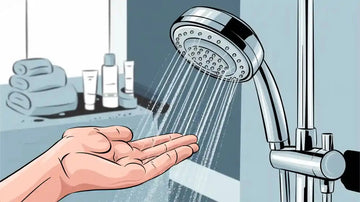You have many good choices besides a filter shower head for cleaner water. These choices are whole house filtration, inline showerhead filter units, water softeners, portable purifiers, and DIY solutions. The Cobbe DS Filter Shower Head is a top filtered showerhead. But this guide talks about other choices. Taking out chlorine and other bad things keeps you healthy.
Statistical Evidence
Description
People who use chlorinated water have a much bigger health risk (U.S. Council of Environmental Quality).
Inhalation > ingestion exposure
Showering can give you up to 100 times more chlorine than drinking water (EPA).
Key Takeaways
Whole house filtration systems clean all the water in your house. They remove chlorine, heavy metals, and bacteria. These systems cost more money. You need a professional to install them.
Inline showerhead filters go between your shower arm and shower head. They are simple to put in. They remove chlorine and some other bad things. They do not cost as much as whole house systems.
Water softeners and conditioners help with hard water. They lower minerals and stop scale from building up. They do not take out chlorine or many other bad things. Using them with filters works better.
Portable water purifiers are good for trips or short use. They can make water pressure lower. They do not clean water as well as shower filters.
DIY and natural ways can lower some chlorine. They do not protect you from heavy metals or bacteria. Commercial filters clean water better and are safer.
Whole House Filtration
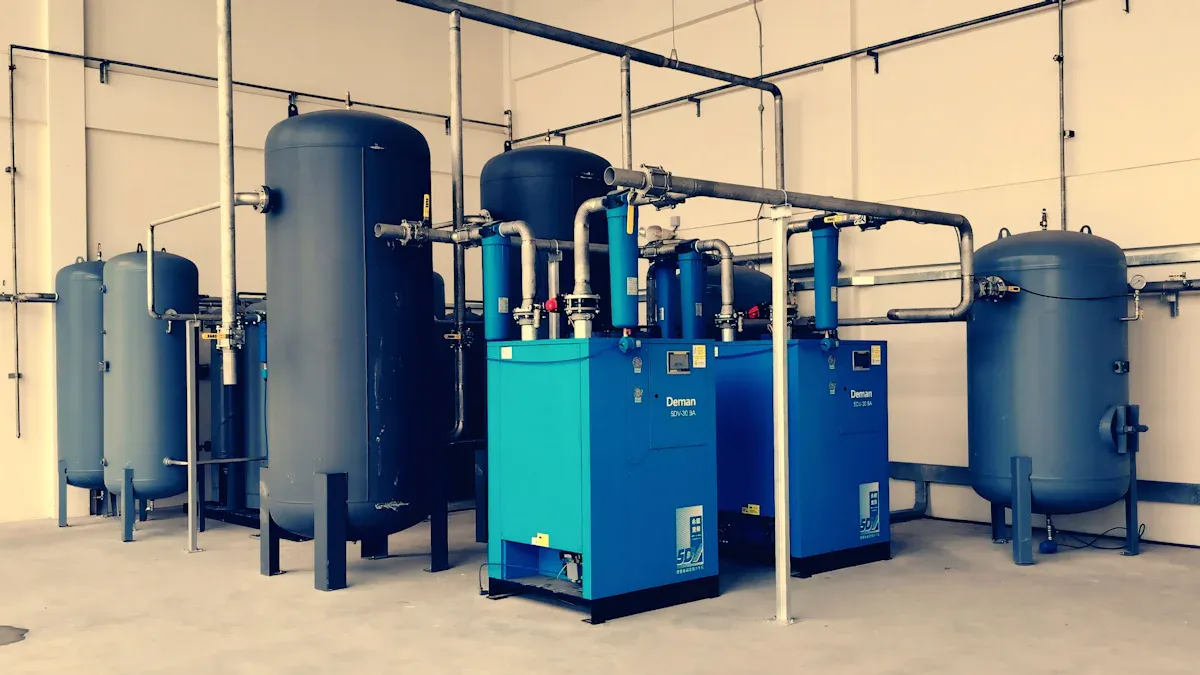
Removing Chlorine and Contaminants
Whole house water filtration systems clean all the water in your home. They protect you from chlorine, heavy metals, and other bad things in every tap, even your shower. These systems use different filters like activated carbon, KDF, and sometimes reverse osmosis membranes. This mix is good at taking out chlorine and heavy metals like lead and mercury. Studies show whole house filtration can lower chemical contaminants, including fluoride, to almost zero. Some systems also get rid of bacteria and viruses, so your water is safer for showering and drinking.
Showerhead Filter |
Whole House Filtration Systems |
|
|---|---|---|
Targeted Water Source |
Shower water only |
All household water (shower, drinking, cooking, etc.) |
Filtration Media |
KDF 55, activated carbon, calcium sulfite |
Activated carbon, KDF, reverse osmosis, sediment filters |
Effectiveness at Removing Chlorine and Heavy Metals |
Highly effective for shower water |
Comprehensive removal across all water uses |
Installation |
Easy, no professional help needed |
Requires professional installation |
Maintenance |
Filter replacement every 3-6 months |
Regular maintenance, higher cost |
Cost |
Low initial and maintenance cost |
Higher installation and maintenance costs |
Scope of Benefit |
Improves shower water quality |
Benefits all household water, protects pipes |
Suitability |
Focused on shower water |
Best for families and homes with poor water quality |
Limitations |
Only filters shower water |
Higher cost and complexity |
Pros and Cons
A whole house water filtration system gives you many good things. It takes out lots of contaminants like chlorine, chloramine, pesticides, bacteria, and heavy metals. This helps your skin and hair feel softer and healthier. It also keeps your pipes and appliances safe from hard water scale. You might notice your bathroom air is better because less chemical steam comes out during showers. Some people think filtered water tastes and smells better, too.
Tip: Whole house filtration can make your home worth more and is a smart choice for families.
But there are some downsides. The first cost is high, usually between $300 and $2,000. You need space to put it in, often in a garage or basement. These systems are not easy to move, so renters may not like them. You also have to do regular maintenance and change filters.
Installation and Cost
Putting in a whole house water filtration system is harder than adding a shower filter. You usually need a plumber to help. The job means turning off your main water, cutting pipes, and hooking up the system. Installation costs can be from $400 to $1,500, depending on your house. The system itself can cost $300 for basic ones or over $3,000 for fancy ones. Maintenance costs are more than a showerhead filter, but you get clean water everywhere. If you want the best chlorine removal and protection from contaminants in your whole house, this choice gives you peace of mind.
Inline Showerhead Filter Alternatives
Inline showerhead filters are another way to clean shower water. These filters go between your shower arm and showerhead. You do not have to get a new showerhead. This is not like a filter shower head, which has both in one. Many people pick inline showerhead filters because they fit most showerheads. They are also simple to put in.
Best Shower Filter Options
There are many shower filters that take out chlorine and other bad things. The best ones use KDF-55, an activated carbon filter, or vitamin C. KDF-55 is a copper-zinc mix that removes chlorine, heavy metals, and some bacteria. An activated carbon filter catches chemicals, smells, and organic stuff. Vitamin C filters get rid of chlorine and chloramines. Some filters use more than one of these for better cleaning.
Here is a quick look at popular inline showerhead filter brands:
Feature |
Sprite |
Rainshow’r |
Culligan |
|---|---|---|---|
Certification |
NSF Certified |
WQA Certified |
NSF Certified |
Filtration Technology |
Clorgon |
KDF-55 & Crystalline Quartz |
KDF-55 |
Chlorine Removal Effectiveness |
Great |
Great |
Good |
Cost per Year |
$18-$32 |
$27-$45 |
About $28 |
Material Construction |
Brass, Plated Plastic, or Plastic |
Plastic |
Plated Plastic or Plastic |
Style Options |
Multiple |
Standard Stationary, Bath Ball |
Standard Stationary, Detachable Hand-Held |
Finish Options |
White, Chrome, Nickel |
White only |
White, Chrome |
Staff Ratings |
A+ |
A |
A+ |
Sprite and Culligan are the best for taking out chlorine. They also have high staff ratings. Rainshow’r works well too and uses KDF-55 and quartz.
Compatibility and Installation
Most inline showerhead filters are easy to put in by yourself. They fit between the shower arm and showerhead. Before you buy, check these things:
Water pressure: Make sure the filter works with your water pressure.
Thread size: Most homes use 1/2" NPSM threads. Some showers use 3/4".
Connection type: Filters can be threaded, compression, or push-fit. Threaded ones are most common and strong.
Installation type: Inline filters need a little more plumbing skill than built-in ones. But they are easier to keep up.
Tip: Always check your shower’s thread size and water pressure before you buy. This helps stop leaks and gives you the best results.
Maintenance and Cost
You should change the cartridge in your shower filter every 3 to 12 months. Each cartridge costs $5 to $40. This means you spend about 2 to 16 cents for each shower. Clean the showerhead and rinse the filter screen to keep water flowing. Multi-stage shower water filters need the same care. You can put in a water-efficient shower filter without a plumber. Keep extra cartridges ready for easy changes. Using a water-efficient shower filter saves money and water over time.
Water Softeners and Conditioners
Reducing Hardness and Odors
Water softeners and conditioners help with hard water in your shower. Water softeners use ion exchange to take out minerals like calcium and magnesium. They swap these minerals for sodium ions. This gives you softer water that feels nicer on your skin and hair. Soap makes more bubbles, and you see less soap scum on the shower walls. Water softeners also stop limescale from building up in pipes and appliances. This helps them last longer.
Water conditioners work in a different way. They do not take minerals out of the water. Instead, they change how minerals act by using things like template-assisted crystallization or electromagnetic waves. This keeps minerals from sticking to surfaces and making scale. Some conditioners also help with bad smells by removing things like chlorine and organic compounds. Your water smells and tastes better, and your shower feels fresher.
Effectiveness vs. Best Shower Filters
It is important to know that water softeners and conditioners focus on hard water, not on taking out contaminants. Softeners remove hard minerals but do not get rid of chlorine or other chemicals. Conditioners might lower some chlorine and smells, but their main job is to stop scale. Shower filters are made to take out chlorine and many other contaminants. They use things like activated carbon to make your shower water safer for your skin, hair, and breathing.
Treatment Type |
Removes Hard Minerals |
Removes Chlorine |
Removes Contaminants |
Main Benefit |
|---|---|---|---|---|
Yes |
No |
No |
Softer water, less scale |
|
Water Conditioner |
No (alters minerals) |
Some |
No |
Less scale, some odor control |
No |
Yes |
Yes |
Removes chlorine, contaminants |
Note: For the best results, you can use a water softener or conditioner with a shower filter. This way, you fix both hard water and contaminants.
Suitability for Different Households
If you live where water is hard, a water softener helps you most. You will notice softer skin, shinier hair, and less limescale on your fixtures. People with sensitive skin or eczema often feel better with softened water. If you use well water, a softener helps stop minerals from causing stains and scale.
Water conditioners are good if you want less scale but want to keep healthy minerals in your water. They are a smart pick if you want something easy to care for and salt-free. If you need to avoid extra sodium, conditioners are better for you. Some places do not allow water softeners, so conditioners are helpful there. For the best shower, think about your water and health needs before you choose.
Portable Water Purifiers
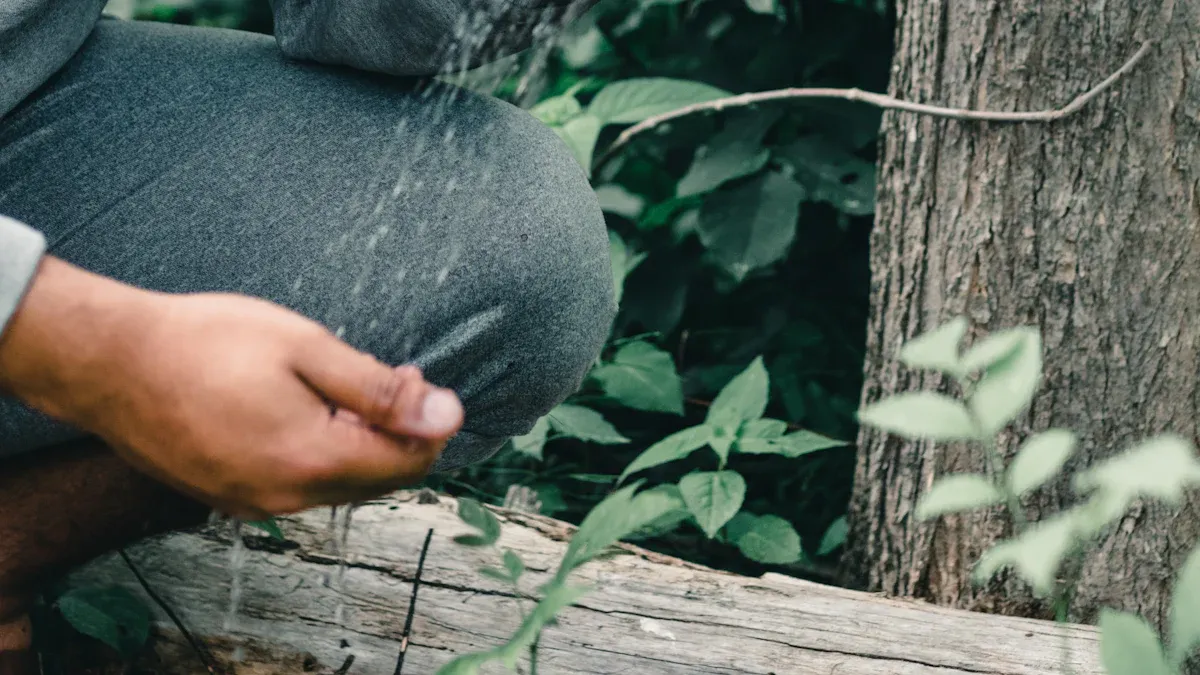
Types and Use Cases
Portable water purifiers are another way to clean shower water. You can use them when you travel or go camping. They are also good if you cannot put in a filter at home. Some people use them for emergencies or just for a short time.
Here are some portable water purifiers you might use for showers:
Activated Carbon Filters: These filters take out chlorine from water. They work best with cold or warm water. If the water is too hot, they do not work as well.
KDF (Kinetic Degradation Fluxion) Filters: KDF filters remove chlorine, chloramine, heavy metals, and some germs. They work well with hot shower water.
Vitamin C Filters: These filters get rid of chlorine and chloramine. They are gentle on your skin and hair. They do not take out many other bad things.
Portable UV Purifiers: UV devices kill germs like bacteria and viruses. They do not take out chemicals or heavy metals. You need another filter for those.
You might want a portable purifier if you have sensitive skin or allergies. They can help stop dryness, itching, and skin problems. Many people use them to keep their hair and skin safe from harsh chemicals. If you rent or move a lot, portable purifiers are easy to take with you.
Tip: Always check if your water has chlorine or chloramine. Some filters work better for one than the other.
Limitations Compared to Showerhead Filter
Portable water purifiers have some problems when used for showers. Most do not work well with strong water flow. You may notice the water pressure is lower. Many portable filters need to be changed often, which can cost more money. Some types, like UV purifiers, do not take out chlorine or heavy metals.
Feature |
Portable Purifier |
Showerhead Filter |
|---|---|---|
Removes Chlorine |
Some types |
Yes |
Removes Heavy Metals |
Rarely |
Yes |
Removes Bacteria |
UV, KDF |
KDF (some), not all |
Handles Hot Water |
KDF, some carbon |
Yes |
Water Pressure |
Often reduced |
Maintained |
Installation |
No tools, portable |
Easy, stays in place |
Portable purifiers are best for travel or short-term use. For daily showers at home, a showerhead filter or inline filter works better and feels more comfortable.
DIY and Natural Methods
Home Solutions for Removing Chlorine
You can try some home ways to take out chlorine from shower water. Some people use vitamin C tablets or powder. You can mix vitamin C with water and spray it on your skin or hair after you shower. This helps get rid of chlorine, but it does not take out other bad things. Boiling water is another way to take out chlorine. When you boil water, the chlorine leaves as a gas. But boiling enough water for a shower is hard for most people.
Some people make a homemade filter with activated carbon. You can put activated carbon in a small container and run water through it before your shower. This can help take out chlorine and some chemicals. It may not work well with hot water or fast water flow. Other natural ways are soaking showerheads in vinegar or lemon juice. These ways clean off hard water buildup. They do not take out chlorine from the water you use in your shower.
Tip: DIY ways can help clean surfaces and lower small amounts of chlorine. But they do not protect you from all bad things in water.
Practicality for Showers
DIY and natural ways have limits for daily showers. Most home ways do not filter water while you shower. They might help take out a little chlorine, but they do not take out heavy metals or bacteria. You might use these ways to clean your showerhead or for a quick fix. But they do not keep you as safe as a commercial filter.
Method |
Removes Chlorine |
Removes Heavy Metals |
Easy to Use Daily |
Safe for Regular Use |
|---|---|---|---|---|
Vitamin C (ascorbic acid) |
Yes (some) |
No |
Somewhat |
Yes |
Boiling Water |
Yes |
No |
No |
Yes |
Activated Carbon Filter (DIY) |
Yes (some) |
Some |
No |
Maybe |
Vinegar/Lemon Juice Soak |
No |
No |
Yes |
Yes |
Commercial shower filters use many steps to take out chlorine, heavy metals, and other bad things. These filters make water better, protect your skin and hair, and are easy to use. DIY ways can help with cleaning and small fixes. But they do not work as well or keep you as safe as a good shower filter. For daily showers, you get better results and feel safer with a commercial filter.
Comparison Table: Best Shower Filters and Alternatives
Effectiveness
You want to find out which choice really makes your water clean. Each way works on different things in the water. A showerhead filter like the Cobbe DS takes out chlorine and heavy metals from shower water. Whole house systems clean all the water in your house, not just the shower. They work for your kitchen and laundry too. Inline filters go between the shower arm and head. They work like a showerhead filter but let you keep your own showerhead. Water softeners take out hard minerals but do not remove chlorine. Portable devices and DIY methods help in special cases. They may not take out as many bad things.
Solution |
Removes Chlorine |
Removes Heavy Metals |
Removes Hard Minerals |
Removes Bacteria |
Certification |
|---|---|---|---|---|---|
Showerhead Filter |
Yes |
Yes |
No |
Some (KDF) |
Some NSF/ANSI |
Whole House System |
Yes |
Yes |
Yes (with softener) |
Yes (RO/UV) |
Many NSF/ANSI |
Inline Filter |
Yes |
Yes |
No |
Some (KDF) |
Some NSF/ANSI |
Water Softener |
No |
No |
Yes |
No |
Some NSF/ANSI |
Portable Device |
Some |
Rarely |
No |
Some (UV/KDF) |
Few |
DIY Method |
Some |
No |
No |
No |
None |
You get the best cleaning with a whole house system or a good showerhead filter.
Cost and Maintenance
You should think about how much each choice costs and how often you need to take care of it. A showerhead filter does not cost much at first. You need to change the filter every few months. Whole house systems cost more to buy and keep working. But they protect all the water in your home. Inline filters and portable devices cost less but need new filters more often. DIY methods are cheap but do not protect you as well.
Solution |
Average Cost (USD) |
Maintenance Needs |
Lifespan/Replacement Interval |
|---|---|---|---|
Showerhead Filter |
Replace filter every 3-12 months ($8-$30) |
4-6 months per cartridge |
|
Whole House System |
$1,000 - $3,000 |
Annual filter change, pro servicing |
5-15 years (system), 6-12 months (filters) |
Inline Filter |
$20 - $200 |
Replace filter every 3-12 months |
4-12 months per cartridge |
Water Softener |
$1,000 - $3,000 |
Salt refills, resin cleaning |
10-15 years (system) |
Portable Device |
$20 - $100 |
Frequent filter changes |
2-6 months per filter |
DIY Method |
Under $20 |
Frequent prep or replacement |
Varies, often short-term |
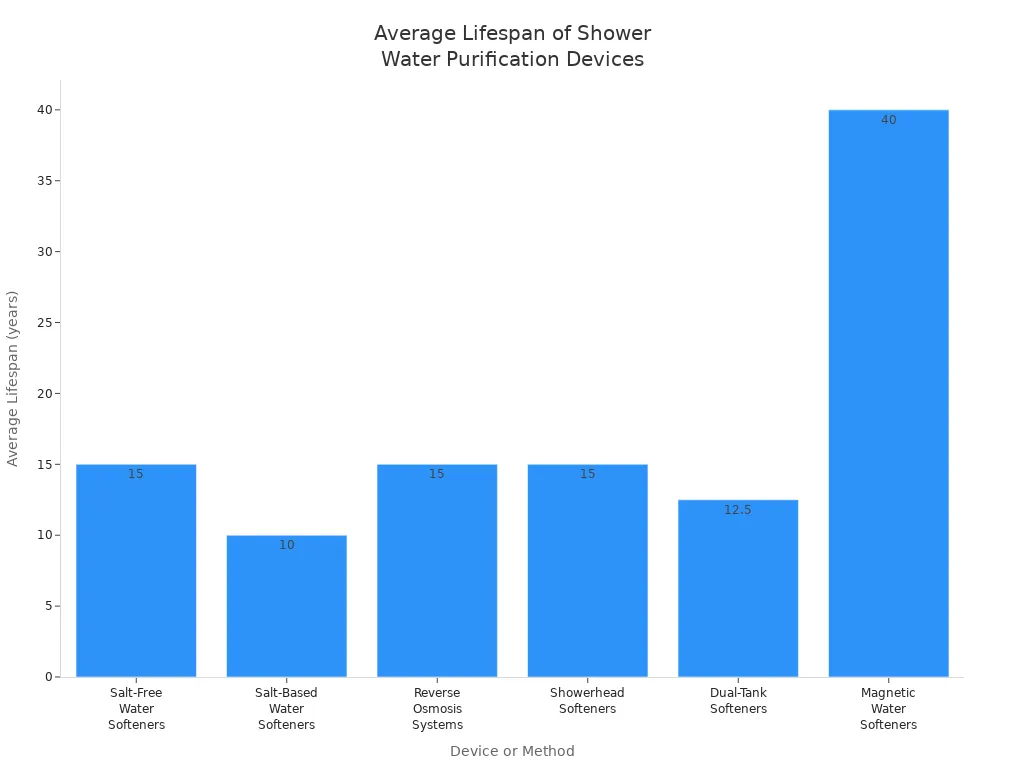
A shower filter or inline filter is a good pick for most homes. They do not cost too much and are easy to care for.
Installation Ease
You want something that is easy for you to set up. A showerhead filter is simple to put on and needs no tools. Inline filters are also quick to add. Whole house systems and water softeners need a plumber and take more time. Portable devices do not need to be installed but may not work well for daily showers. DIY methods need work each time you use them.
Easiest to install: Showerhead filter, inline filter, portable device
Most complex: Whole house system, water softener
DIY methods: No setup, but not good for daily showers
If you rent or move a lot, a showerhead filter or inline filter is the best for clean water and easy setup.
Choosing the Right Solution
Assessing Water Quality
You want to pick the best way to clean your shower water. Start by checking what is in your water. Follow these steps to make a smart choice:
Test your water or look up your local water quality report. Find out if you have chlorine, lead, bacteria, or other contaminants.
Think about how much water your family uses every day. Bigger families need filters that can handle more water.
Match the filter type to the problem. For example, KDF filters work well for chlorine and heavy metals. Vitamin C filters target chlorine and chloramine.
Check if the filter fits your shower and is easy to install.
Look at how often you need to change the filter. Pick something you can keep up with.
See if the filter has extra features, like a spray setting or a filter life indicator.
Ask local experts or read reviews to find trusted brands.
These steps help you choose a water filtration solution that fits your needs.
Budget and Household Needs
Your budget and the size of your household matter when picking a water filtration method. The table below shows how these factors affect your choice:
Factor |
How It Affects Your Choice |
|---|---|
Budget |
Cheaper options give basic cleaning. Premium filters last longer and clean more. Balance cost and value. |
Household Size |
More people mean more water use. You will need to change filters more often. Larger systems may save money. |
Maintenance |
Big families need filters that are easy to replace. Maintenance costs add up with more users. |
Compatibility |
Make sure the filter works with your shower and water pressure. |
If you live alone or rent, a showerhead filter or inline filter is easy and affordable. For large families or homes with many bathrooms, a whole house water filtration system makes sense. DIY methods work if you have a tight budget and some technical skills, but they do not offer as much protection.
💡 Tip: Eco-friendly water filtration systems help the planet. They cut down on plastic waste and save water.
You can find the right solution by looking at your water quality, budget, and living situation. A filter shower head like the Cobbe DS works well for most people who want easy setup and strong cleaning. Choose a bigger system if you need whole-home protection or have special water problems.
You can make your shower water better in many ways and keep yourself healthy.
Whole house systems are best for families who want clean water everywhere.
Portable softeners are good for renters or people with hard water.
Inline filters and multi-stage shower filters help take out chlorine and heavy metals. This makes your skin and hair feel softer.
Always pick products that are certified and test your water before you buy.
Taking out chlorine and other bad things helps your skin, hair, and health. Most people say their skin feels less itchy and their hair is healthier after using filtered water.
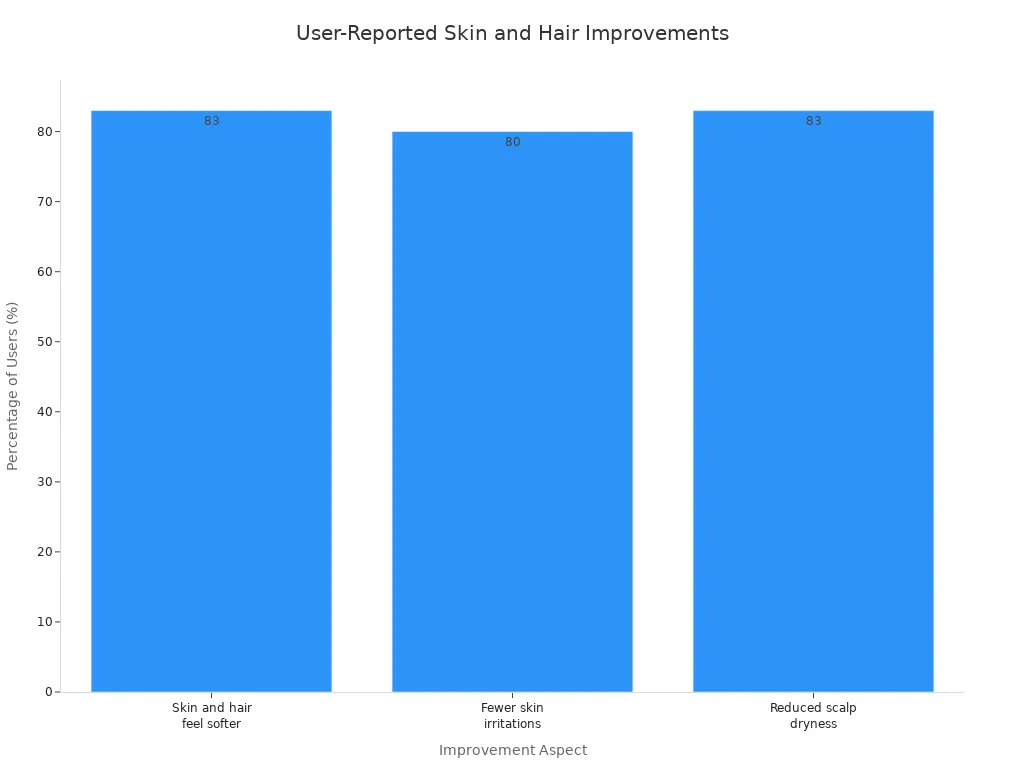
Pick the choice that works for you and enjoy feeling healthier every day.
FAQ
What is the best alternative to a filter shower head for clean water?
A whole house filtration system is a great choice. It cleans all the water in your house, not just the shower. This system takes out chlorine, heavy metals, and other bad things. You get safer water for drinking, cooking, and bathing.
Can I use a water softener instead of a shower filter?
A water softener takes out hard minerals like calcium and magnesium. It does not take out chlorine or most chemicals. For the best results, use both a softener and a shower filter.
How often should I change an inline shower filter?
Most inline shower filters need changing every 3 to 12 months. The time depends on your water and how much you use. Always read the manufacturer's instructions for the best advice.
Are DIY methods safe for daily shower use?
DIY ways, like vitamin C or homemade carbon filters, can lower some chlorine. They do not take out heavy metals or bacteria. Certified filters are safer for daily use and better for your health.
Do portable water purifiers work for showers?
Portable purifiers are helpful when you travel or rent. They can lower chlorine and some germs. Most do not work well with hot water or strong flow. For daily showers, a shower filter or inline filter works better.
